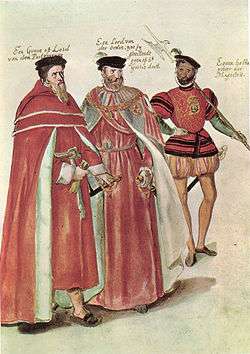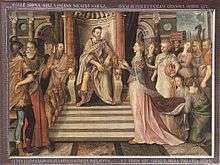Lucas de Heere

Lucas de Heere (1534 – 29 August 1584) was a Flemish portrait painter, poet and writer.
De Heere, a Protestant, was born in Ghent, and became a refugee from the Dutch Revolt against Philip II of Spain, who tried to suppress Protestantism. De Heere had to flee to England, where he became an elder of the Dutch stranger church of Austin Friars. After the Pacification of Ghent in 1576 he was able to return home, if only for a while. He was once again forced to leave the city in 1584 when Ghent surrendered to Spanish Habsburg forces.[1]
He was very popular during his career and became immensely rich. His portrait of Katheryn of Berain is held by the National Museum Cardiff. He painted a head of Philip II from the life in 1553, as a letter of Cardinal Granvelle documents; this is presumed to be the painting now in the Prado.[2]
In 1559 he painted by order of the ambassador Viglius van Aytta La visita de la reina de Saba a Salomón, who was commissioned for the closing of the Choir of St. Bavo's Cathedral in Ghent before the celebration of the XXII chapter of the Order of the Golden Fleece, conserved in situ. In the canvas the image of Philip II, the prudent king, is already presented, like the new King Solomon, announcing the use of the Solomonic model in El Escorial. In the picture of Lucas de Here, Salomón takes the features of Felipe II, blond, with beard and outgoing chin, while the Queen of Saba appears as an allegory of the Netherlands, who give their riches to the king in exchange for this govern them wisely and prudently.
In England he trained other young Netherlanders: John de Critz, probably Marcus Gheeraerts the Younger, and possibly as well the English Robert Peake the Elder.
Some time between 1573 and 1575, working on-site, he painted Stonehenge - the sketch is now in the British Library, and is the earliest known realistic depiction of the site.[3]

See also
References
- ↑ http://literairgent.be/lexicon/auteurs/dheere-lucas/
- ↑ Museo del Prado, Catálogo de las pinturas, 1996, p. 172-3, Ministerio de Educación y Cultura, Madrid, No ISBN
- ↑ "Stonehenge, Corte Beschryvinghe van Engheland, Schotland, ende Irland | British Library - Picturing Places". The British Library. Retrieved 20 March 2018.
Further reading
- Van Dam, Frederica (2014). "'Tableau Poétique': A Recently Discovered Manuscript by the Flemish Painter-Poet Lucas D'Heere (1534–84)". Dutch Crossing. 38 (1): 20–38. doi:10.1179/0309656413Z.00000000046.
External links
| Wikimedia Commons has media related to Lucas de Heere. |
- CC-licensed High-Resolution scans at Ghent University Library
- 6 paintings by or after Lucas de Heere at the Art UK site